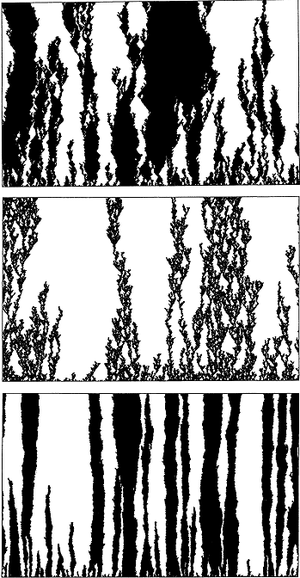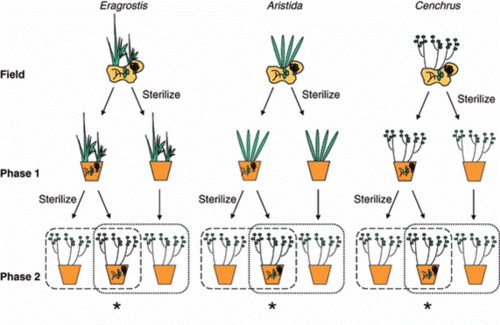Plant-soil feedback
Introduction
Definition
Changes to soil properties that are caused by plants, which in turn influence the performance of plants are termed as ‘plant–soil feedbacks’ (Putten et al., 2013). Through changes in the demography of the plant population and/or the physiological activity of the individual plants, the plant’s effect on the soil condition increases (positive feedback) or decreases (negative feedback) (Ehrenfeld et al., 2005). Microbial activity and community composition is considered as one of the major drive factor of plant-soil feedback effects (Bever et al., 2013; Klironomos, 2002)
Basic approaches
The basic approach of plant–soil feedback experiment is that plant first influence the composition of the soil community, which is the soil conditioning phase. Then, the effects of conditioning are evaluated by assessing soil effects on subsequent plant growth (Figure 1) (Perkins and Nowak, 2013; Pernilla Brinkman et al., 2010). In the early years, most of the experiments started the plant soil feedback experiment from field-sampled soil (Vanderputten et al., 1993). This approach strengthens the influence of plant on soil under natural conditions. However, the weakness of this approach is that soils in natural condition can be affect by a lot of factors and the composition of the soil community and abiotic properties may be changed (Pernilla Brinkman et al., 2010).
A following developed approach was that plant species were grown in living soils to develop a soil community, which is the conditioning phase. Then the growth response on changed biotic conditions was tested which is the test phase. The advantage of this two-phase approach is that the effects from possible side effects of natural conditions are avoided and the abiotic conditions are controlled. However, the disadvantage of this approach is that there will be difference between the soil condition in greenhouse and that in the field (Pernilla Brinkman et al., 2010). This weakness may make it difficult to explain what was happened in the natural conditions.
History and importance
Humans have been aware of and managed plant–soil feedbacks in agriculture and horticulture for more than 1000 years. In agricultural settings, plant–soil feedbacks often involves in soil nutrient depletion or the build-up soil-borne pathogens (Putten et al., 2013). For example, the productivity of some crops declined and the rhizosphere community changed in the monocropping system (Bopaiah and shetty, 1991). Rotational cropping systems and intercropping system would help to reduce monocropping obstacles and to increase productivity (Bopaiah and shetty, 1991; van der Putten et al., 2013) Interest in plant–soil feed-backs has increased markedly in the past 20 years (Figure 2). Many exciting results are released. Plant–soil feedbacks is becoming an important concept for explaining vegetation dynamics, the invasiveness of introduced exotic species in new habitats and how terrestrial ecosystems respond to global land use and climate change (van der Putten et al., 2013).
Factors that influence the results of plant-soil feedback
Factors that influence the results of plant-soil feedback have been thoroughly reviewed by Ehrenfeld (Ehrenfeld et al., 2005).
Physical factors
Water: plant roots’ ability of taking up water alters the distribution and amount of water in the soil, which affects the physical traits of soil as well as the growth and reproduction of plants their selves (Ehrenfeld et al., 2005). Soil aggregation: Roots affect aggregation through plant carbon (C)-based microbial growth, the production of plant and microbial mucilages, the presence of phenolic compounds in root exudates, and the overall input of SOM. Feedback between plants and the physical properties of soils arise from the promotion of aggregates by roots and root-associated microorganisms (Ehrenfeld et al., 2005). Soil temperature affects root growth, water availability, and microbial activity, thus affecting both nutrient cycling and soil respiration (Ehrenfeld et al., 2005).
Chemical factors
pH: The generation of carbonic acid from plant roots and imbalance uptake of positive and negative ions are important acid sources of soil. pH involved in plant-soil feedback because plant-induced acidification may promote conditions which only acidophiles can live (Ehrenfeld et al., 2005). Oxygen: some plants release oxygen from their roots and change redox conditions in soil which are presumed to be part of the feedback cycle (Ehrenfeld et al., 2005). Carbon and nitrogen cycle: different decomposition and mineralization rates, N cycling and C cycling are considered to be important factors that influence the results of plant soil feedback experiments (Ehrenfeld et al., 2005).
Key microorganisms
Current research

Plant–soil feedbacks is becoming an important concept for explaining vegetation dynamics, the invasiveness of introduced exotic species in new habitats and how terrestrial ecosystems respond to global land use and climate change.
Primary and secondary succession
Early successional stages are often associated with positive plant–soil feedbacks, for example, due to symbiotic nitrogen fixation and plant associations with mycorrhizal fungi. Then the initial benefit of symbioses may become a disadvantage when early successional plant species develop negative soil feedback such as the pathogen accumulation. This reduces their competitive ability against later successional plant species which are tolerant of the pathogens accumulated by earlier successional species. Moreover, plant community composition in early stages of secondary succession can also change rapidly due to negative plant–soil feedbacks. For example, in a series of old fields that differed in time since abandonment, early successional (weedy) plant species demonstrated negative feedback effects, whereas later successional species had positive plant–soil feedbacks effects (Kardol et al., 2006; Putten et al., 2013).
Biological invasion
The success of many invasive species can be explained by plant-soil feedback method. One of the main reasons why exotic species can become so invasive in their new range is that they become released from specialist natural enemies that control abundance in the native range. In a study in a Canadian old field, introduced exotic plant species had neutral to positive plant–soil feedbacks comparable to dominant native plant species which had negative feedbacks (Klironomos, 2002). This finding was taken to suggest that exotic plant species could become invasive by not being exposed to negative plant–soil feedbacks (Putten et al., 2013).
Plant abundance and rarity
Plant-soil feedback can be used to explain the relative abundance and rarity of plant species. Recent work has shown that reduced success of conspecific seedlings near adults (conspecific negative density dependence) in the tropics can be attributed to local scale plant–soil feedbacks (Mangan et al., 2010). Failed establishment of black cherry (Prunus serotina) seedlings under conspecific adults was due to pathogenic soil microbes (Pythiumsp.). Subsequent work has suggested that the decline in performance and abundance of seedlings near conspecific adult trees is common in both tropical and temperate forests (Putten et al., 2013).
Climate change
Both temperature increases and altered precipitation patterns are likely to influence plant–soil feedbacks, with potentially far-reaching consequences for ecosystem functioning. Climate change is likely to impact the soil organisms directly because warming of the soil can stimulate microbial activity, the breakdown of organic matter and hence the loss of carbon from soil. The numerous routes by which climate change can impact plant–soil interactions and ecosystem functioning can operate at a variety of spatial and temporal scales. At the individual plant level, and over intra- and inter-annual timescales, changes in temperature, water availability and rising atmo-spheric carbon dioxide (CO2) concentration, all impact plant photosynthesis and the transfer of photosynthetic carbon to soil, with cascading effects on soil organisms and ecosystem functioning.
References
Edited by <Meng LI>, a student of Angela Kent at the University of Illinois at Urbana-Champaign.

